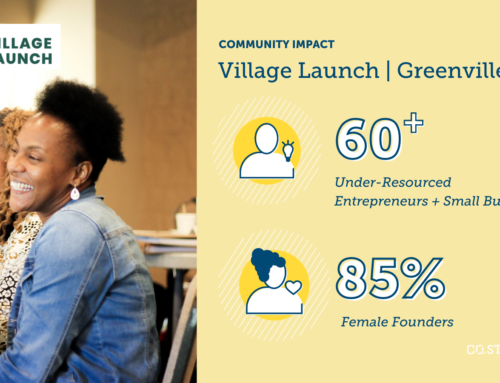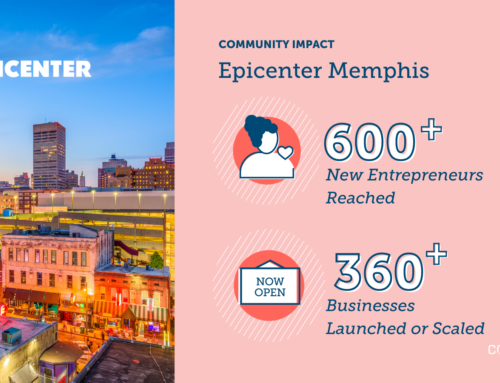And how to manage your cash flow right now as a small business.
Although some businesses have seen the relief offered by the CARES Act—particularly the Paycheck Protection Program SBA loans—many small businesses have been left wondering if their application is even being considered.
This financial limbo is a really tough place to be, because managing cash flow is a “right now” problem. Federal loans are showing themselves to be solutions of the distant future.
So what exactly is going on? Why aren’t businesses hearing back about their loans? And what should they do in the meantime? To answer these questions, we brought in Brian Pifer, the Vice President for Entrepreneurship at Small Business Majority and Venturize, as a guest on one of our Straight Talk with Starters sessions.
Jose Alfaro, COO of CO.STARTERS, led the session and fielded some common questions for Brian:
Jose: What should we know about these government loans? What are some best practices for using them to survive at this time?
Brian: There are two kinds of SBA loans applicable specifically to COVID-19. The Paycheck Protection Program loans (PPP loans) have gotten way more attention, since the fund has more money. But there are also these Economic Injury Disaster Loans (EIDL) that are not as well-known. Both loans ran out of funding in late April, but Congress voted to replenish the funds.
The PPP loans are primarily for maintaining payroll—keeping as many employees as you can hold onto. The funds for these loans were disbursed to many different lenders around the country—mostly banks. You apply for the loan through one of these lenders. Unfortunately, most banks are only processing PPP applications from existing clients. It’s turning out to be very difficult to get a loan through a bank if you haven’t used that bank before.
We do keep a list on our website of different lenders whom we believe are processing applications from new clients. But we can’t even be 100% certain about those lenders either.
The first thing every small business owner should do is apply for a PPP loan as long as the applications are open. Loans are approved by the SBA on a first-come-first-serve basis, so it’s important to get your application in there as soon as possible.
Jose: The government is saying that these loans can be forgiven. How much of a loan can be forgiven, and under what conditions?
Brian: The simple answer is: the total amount of the loan can be forgiven. The amount of money you’re eligible to receive is based on your average monthly payroll from the last 12 months, which you reported on your 2019 tax returns. Once you know the average, multiply it by 2.5. That’s how much money you’re eligible for. 75% of the loan must go to payroll costs—salaries, tips, health insurance premiums, state and local payroll taxes, etc. The other 25% can go toward other costs including mortgage payments, rent, and utilities. If you spend the loan in this manner, the entire amount can be forgiven.
You must document every penny you spend from the PPP loan. The bank will likely ask for it once you request forgiveness.
Jose: What about a business that can’t spend that money on payroll? What if you can’t hire back your furloughed employees because they’re making more on unemployment or don’t want to go back to work?
Brian: This is becoming a very common situation. So let’s say you spend 50% of the loan on payroll costs, since not all of your employees are returning to work. And you spend 25% on rent and utilities. The other 25% of the loan will convert to a two-year loan with interest.
Jose: What about self-employed individuals?
Brian: The SBA has further guidance on this, but self-employed individuals can still get PPP loans. The amount is calculated on your average monthly net profit. Multiply that amount by 2.5, and that’s the maximum amount you can receive.
Jose: What if a self-employed individual hasn’t been able to turn a profit yet? Can they use the loan to cover owner draws?
Brian: Unfortunately not. Owner draws don’t count as payroll costs. If you’re in this position—and many are—contact your CPA or SBDC or SCORE to get help with your individual 1040. Talk to your local bank and explain your financials. Try to make an argument for yourself.
Also, one of the things the CARES act did was allow self-employed people to file for unemployment insurance with the extra $600 per week. This does vary by state unemployment laws, though.
Jose: Are there any grants available to businesses?
Brian: Yeah, so that brings us to the EIDL loans. These are effectively grants of up to $10,000. The application is currently closed, but should be open again once the funds are replenished. Applicants should know that the SBA has only processed 26,000 applications out of the 4 million that have been submitted. So there isn’t a good chance of getting one of these packages. The SBA does have contact info for information on your application’s status, but people aren’t having much success with it. If you do get ahold of someone through the phone, try to upgrade to a higher tier representative—they’ll likely have the more useful information.
Unfortunately, the SBA infrastructure was just not prepared for the rapid and massive influx of applications. That’s the real problem here.
Jose: Some cities have CDFIs with funds available for relief, right?
Brian: We tried to identify these on our Venturize website. But a lot of these institutions have been heavily impacted as well. Many CDFIs have been forced to close. Lots of them are just going to be challenged in terms of their existing portfolios.
The impact of all this will probably result in much higher loan default rates. We’ll probably start to see more state and local efforts propped up through various means—California, for instance, is making a big effort on this right now.
One other piece of legislation that hasn’t gotten attention is that new microloans or 7a loans have zero interest for the first six months. Also, Kiva’s crowdfunding model is a great source for loans at zero interest right now.
Jose: Is there a way we can see which businesses have received the PPP or EIDL funds?
Brian: Not really. They’ve broken it down by state and the size of the loan. In the new laws, there is supposed to be a stipulation that some funds will be set aside for midsize lenders in more needy communities. The only reason we know about some large chain companies getting the loans is because they’ve had to disclose that information in their SEC filings.
Jose: What are some best practices for a business that has been around for a year and has some debt? Is there opportunity to refinance their debt?
Brian: You’re going to see a credit crunch in the coming months, for sure. Things are gonna get backed up, so it’s going to be difficult for a business to prove that they are financially viable. But if you can, there might be opportunities for that. The EIDL advance can be used for existing debt obligations. I would try to find a 7a lender or microloan with no interest for six months.
Jose: How should businesses manage cash flow right now?
Brian: In terms of accounts payable and existing debt obligations, you need to contact those accounts or debtors if you haven’t already. Many are offering deference. Be proactive about this. Be direct and honest. Try to renegotiate payback dates for AP, and see what’s possible. Lastly, collect as much as you can from your accounts receivable.
It stinks that the federal relief is not getting here as soon as we need it. But those steps could be an option as you’re waiting on decisions from PPP and EIDL.
Update: The Washington Post has reported that new EIDL applications are being halted; they will only be processing those that have already been submitted.



Many thanks to Brian for joining us for Straight Talk with Starters. Brian Pifer oversees Small Business Majority‘s Entrepreneurship Program and Venturize.org platform, which deliver key education and resources to entrepreneurs seeking to start and grow their business. He builds partnerships with organizations that serve small business owners, evaluates the program’s activities and impact, and oversees the development of Venturize to ensure it is the one-stop hub for the nation’s entrepreneurs. He manages the website’s MatchFinder tool, which connects entrepreneurs to mission-driven lending partners.

For more information for small businesses navigating the COVID-19 crisis:
- Join an upcoming Straight Talk with Starters session or Refocus workshop.
- Visit the CO.STARTERS Recovery Guide, updated regularly.
- Check out Small Business Majority’s Daily COVID-19 Updates.



